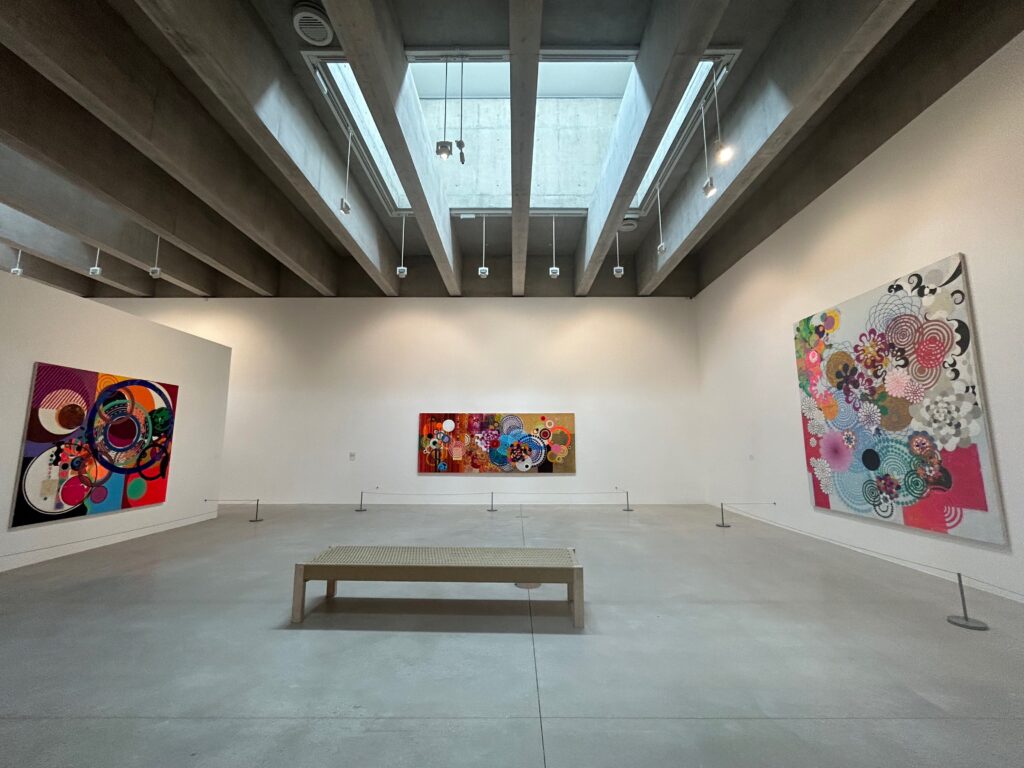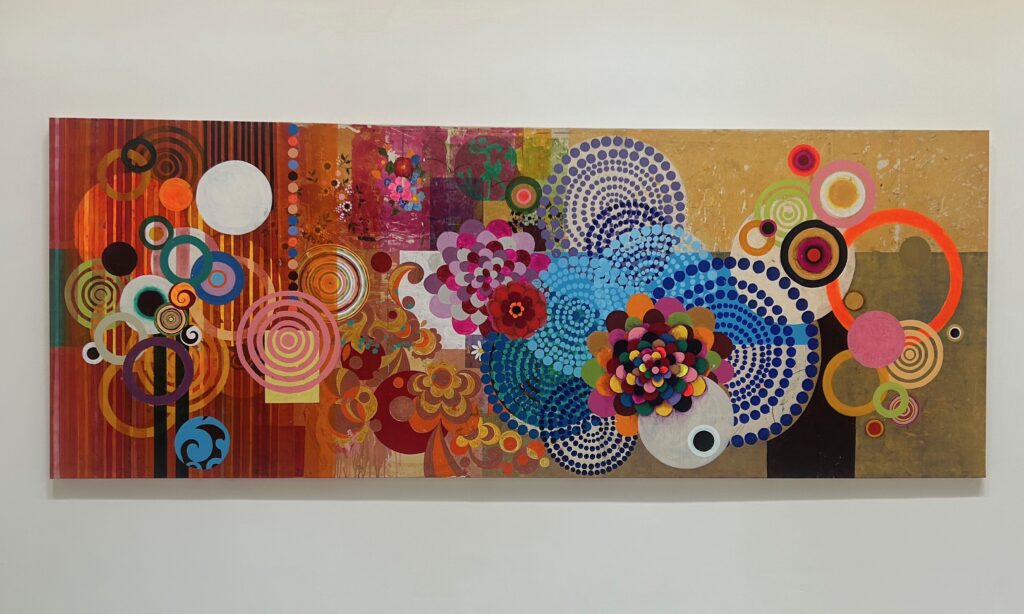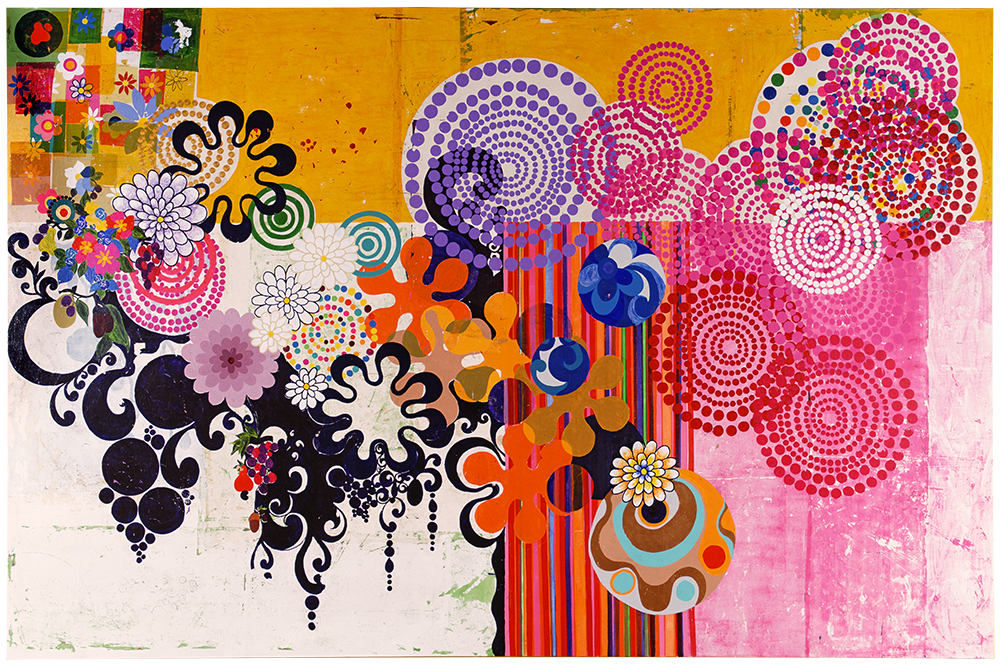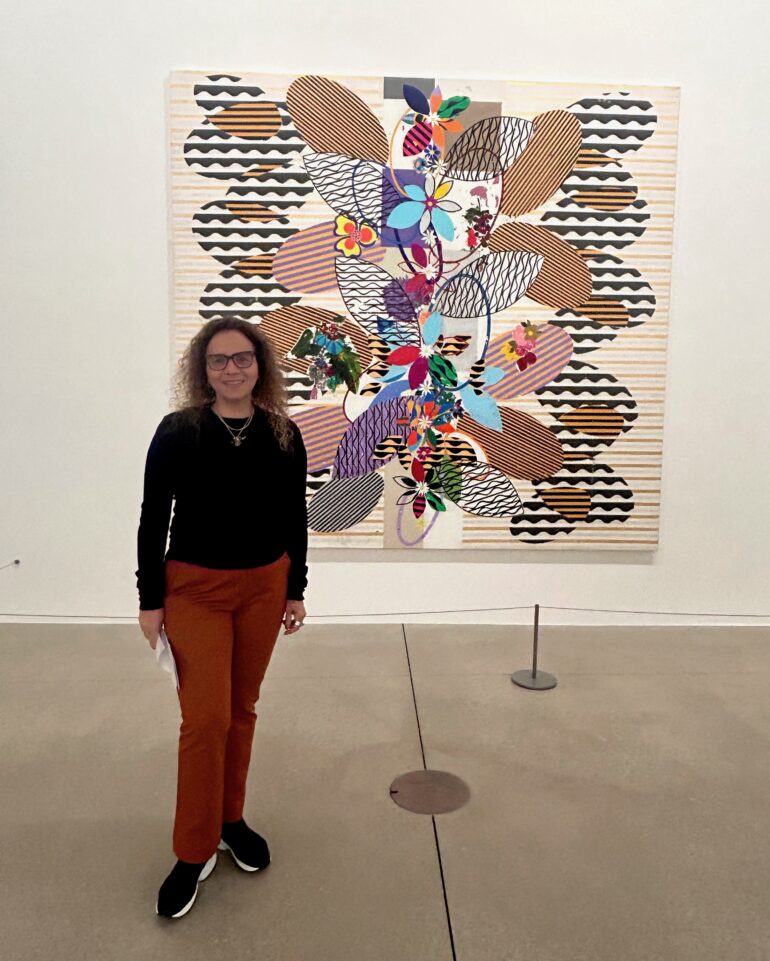One of the world’s most celebrated abstract artists, Beatriz Milhazes emerged in the 1980s as a leading figure in the Geração Oitenta (1980s Generation), a Brazilian art movement which represented a pivot away from the austere conceptual art of the previous decade, towards painting as a joyful, energetic form of expression. Milhazes became known for her epic abstract canvases in colourful palettes which took inspiration from Brazilian heritage and vernacular culture, Catholic iconography and Baroque colonial architecture. She developed her own distinctive visual lexicon with motifs inspired by natural forms such as flowers, trees, plants, suns, stars and the ocean.
Beatriz Milhazes Maresias celebrates the artist’s evolution during a period of four decades, and explores her love of nature and the sea as increasingly prominent themes in her art. The title Maresias refers to the salty sea breeze in the coastal city of Rio de Janeiro that Milhazes calls home.
Maresias was originally exhibited at Turner Contemporary in Margate and is reimagined in St. Ives, another iconic British coastal destination. Margate, St Ives and Rio de Janeiro have in common a magnetic, oceanic aura that has inspired artists for generations, from Turner to Emin in Margate, to Dame Barbara Hepworth and the St Ives School in St Ives, to Beatriz herself in Rio de Janeiro. The presentation of Maresias at Tate St Ives is curated by director Anne Barlow and Assistant Curator Giles Jackson.

Beatriz Milhazes (b.1960, Rio de Janeiro) represented Brazil at the 50th Venice Biennale (2003), participated in the São Paulo Biennial (1998, 2004) and the Shanghai Biennial (2006), and received a UK public commission from Art on the Underground (2005). Milhazes is currently participating in the 60th Venice Biennale at the V&A Applied Arts Pavilion.

Culturalee spoke to Brazilian artist Beatriz Milhazes as she prepared to open her solo exhibition Maresias at Tate St. Ives in Cornwall.
You talk about the sea in Rio de Janeiro being a massive influence on you. Do you feel that there’s a relationship between the oceans that brings together Rio and your experience there, with St Ives and Margate. Is that the thread that runs through these places?
I think it’s one of the links. I am on the tropical coast, but it’s the same water, different culture. For me it’s very interesting to see how people who also experience some sort of coastal life, will dialogue with work that came from a different place with the same kind of beach culture or connection to nature.

As a woman artist, how do you feel about the recent recognition of women by major museums and institutions. For example, Marina Abramovic at the Royal Academy of Arts, Yoko Ono at Tate Modern, Judy Chicago at Serpentine, and you at Tate St Ives. It feels like a long time coming. Do you have any view on why this is happening now, and why it took so long for these women artists to get this recognition?
I think it’s a kind of movement that started maybe 10 years ago. They (museums and institutions) started looking for the history, and some of the women who didn’t have the recognition that they should have. So this is a very important movement, because you need to look at your past to build up the memories of your future for the youngest women artists. It’s good to know that we always had strong women working, even if they weren’t seen or recognised in the way they should have been. That’s basically what is happening now, seriously, and I hope it will continue. Now people are discovering that these women were there, they were intelligent, they were doing serious work, they had a point, and they add something to developments in art history. The important thing is to be thinking seriously about bringing something important, like a legacy.
Like you are building a legacy – and the Tate are with this exhibition – of your work. And Dame Barbara Hepworth, who was very ahead of her time in thinking of her legacy. These Museum shows provide not just a history of art, but a historical record and legacy.
I always admired Hepworth’s work a lot, and it was a great coincidence because I had always planned to come to Cornwall to visit her foundation. So it’s a great honour to be invited to St Ives to exhibit. In terms of international art history Bridget Riley and Barbara Hepworth were pioneers.
You’re exhibiting at the Venice Biennale this year in the V&A Pavilion. Were you invited by the Biennale curator Adriano Perosa, who is also Brazilian?
I’m exhibiting in the V&A Pavilion of Applied Arts in the Arsenale. It’s a collaboration between the V&A and the Biennale, and the curator is Adriano Perosa, who is the curator of the 60th Biennale Arte. It was quite an overwhelming invitation, because the V&A has been one of my favourite museums in the world, since I first visited in 1985. Because I have this connection with design and applied arts, so the V&A is part of my life and my development. I’ve known the curator Adriano Perosa for a long time, and we’ve done different projects together. So when he knew about the Pavilion, he immediately thought I was perfect for it. It’s just one artist, and it’s a kind of communication between applied art and contemporary art.
Applied arts is an art form that’s getting recognition now, which wasn’t always recognised as a high art. But now it’s becoming recognised as a fine art. So you were an early pioneer for the recognition of applied arts.
When I started, to mention my fascination with applied arts and how I wanted to take it to the painting field, was very delicate. I’m a woman from Latin America using popular art as a reference, so to be taken seriously as an artist in the 90s, when I started my international career, was like walking on egg shells!
Beatriz Milhazes: Maresias is at Tate St Ives from 25th May to 29th September, 2024.



